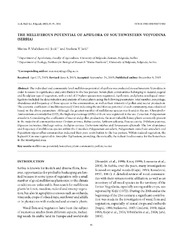Приказ основних података о документу
The melliferous potential of apiflora of southwestern Vojvodina (Serbia)
| dc.creator | Mačukanović-Jocić, Marina | |
| dc.creator | Jarić, Snežana | |
| dc.date.accessioned | 2020-07-06T14:48:43Z | |
| dc.date.available | 2020-07-06T14:48:43Z | |
| dc.date.issued | 2016 | |
| dc.identifier.issn | 1821-4339 | |
| dc.identifier.uri | https://radar.ibiss.bg.ac.rs/handle/123456789/3737 | |
| dc.identifier.uri | http://www.serbiosoc.org.rs/arch/index.php/abs/article/view/745 | |
| dc.description.abstract | The individual and community-level melliferous potential of apiflora was evaluated in southwestern Vojvodina in order to assess its significance and contribution to the bee pasture. Seven plant communities belonging to ruderal, segetal and floodplain type of vegetation, with a total of 279 plant species were registered. Apifloristic and phytocoenological inves-tigations included the determination and analysis of honey plants using the following parameters: total number, percentage, abundance and frequency of these species in the communities, as well as their intensity of pollen and nectar production. The coenotic coefficient of melliferousness (CCm) indicating the melliferous potential of each community, was calculated based on the above parameters. Although the greatest number of melliferous species was found in the ass. Chenopodio-Ambrosietum artemisiifoliae (132), the highest percentage (80%) of them was registered in the ass. Consolido-Polygonetum avicularis. Considering the coefficients of nectar and pollen production, the most valuable honey plants commonly present in the majority of communities were: Cirsium arvense, Rubus caesius, Lythrum salicaria, Daucus carota, Trifolium pratense, Dipsacus laciniatus, Medicago sativa, Asclepias syriaca, Cichorium intybus and Taraxacum officinale. The low abundance and frequency of melliferous species within the Consolido-Polygonetum avicularis, Polygonetum convolvulo-avicularis and Populetum nigrae-albae communities indicated their poor contribution to the bee pasture. Within ruderal vegetation, the highest CCm was registered in Amorpho-Typhaetum, providing, theoretically, the richest food resource for the honeybees in the investigated area. | en |
| dc.language.iso | en | |
| dc.publisher | Serbian Biological Society | |
| dc.relation | info:eu-repo/grantAgreement/MESTD/Basic Research (BR or ON)/173018/RS// | |
| dc.relation | info:eu-repo/grantAgreement/MESTD/Integrated and Interdisciplinary Research (IIR or III)/46009/RS// | |
| dc.relation | info:eu-repo/grantAgreement/EC/FP7/316004/EU// | |
| dc.rights | openAccess | |
| dc.rights.uri | https://creativecommons.org/licenses/by-nc-nd/4.0/ | |
| dc.source | Archives of Biological Sciences | |
| dc.subject | Melliferous potential | |
| dc.subject | Honeybee | |
| dc.subject | Plant community | |
| dc.subject | Pollen | |
| dc.subject | Nectar | |
| dc.title | The melliferous potential of apiflora of southwestern Vojvodina (Serbia) | en |
| dc.type | article | |
| dc.rights.license | BY-NC-ND | |
| dcterms.abstract | Мачукановић-Јоцић, Марина; Јарић, Снежана; | |
| dc.rights.holder | © Serbian Biological Society | |
| dc.citation.issue | 68 | |
| dc.citation.volume | 1 | |
| dc.identifier.doi | 10.2298/ABS150427130M | |
| dc.identifier.scopus | 2-s2.0-84961625720 | |
| dc.identifier.wos | 000377883400009 | |
| dc.citation.spage | 81 | |
| dc.citation.epage | 91 | |
| dc.type.version | publishedVersion | |
| dc.identifier.fulltext | https://radar.ibiss.bg.ac.rs/bitstream/id/6339/bitstream_6339.pdf |

